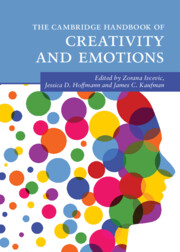Book contents
- The Cambridge Handbook of Creativity and Emotions
- Cambridge Handbooks in Psychology
- The Cambridge Handbook of Creativity and Emotions
- Copyright page
- Dedications
- Contents
- Figures
- Tables
- Contributors
- Acknowledgments
- Creativity and Emotions
- Part I Methods in the Study of Creativity and Emotions
- Part II The Development of Creativity
- Part III Emotions and the Creative Person
- Part IV Emotions and Creative Products
- Part V Emotions and Creativity at School and Work
- 24 Anxiety, Fear of Failure, and Creativity
- 25 Peers, Affect, and Creativity at School
- 26 Creative Curricular Experiences
- 27 Organizational Affective Climate and Creativity at Work
- 28 Group Affect and Creativity
- 29 Psychological Safety and Creativity
- 30 Leadership, Creativity, and Emotions
- 31 A Multilevel Model of Emotions and Creativity in Organizations
- 32 Creativity and Emotion
- Index
- References
26 - Creative Curricular Experiences
Navigating Uncertainties and Emotions toward Creative Expression
from Part V - Emotions and Creativity at School and Work
Published online by Cambridge University Press: 16 February 2023
- The Cambridge Handbook of Creativity and Emotions
- Cambridge Handbooks in Psychology
- The Cambridge Handbook of Creativity and Emotions
- Copyright page
- Dedications
- Contents
- Figures
- Tables
- Contributors
- Acknowledgments
- Creativity and Emotions
- Part I Methods in the Study of Creativity and Emotions
- Part II The Development of Creativity
- Part III Emotions and the Creative Person
- Part IV Emotions and Creative Products
- Part V Emotions and Creativity at School and Work
- 24 Anxiety, Fear of Failure, and Creativity
- 25 Peers, Affect, and Creativity at School
- 26 Creative Curricular Experiences
- 27 Organizational Affective Climate and Creativity at Work
- 28 Group Affect and Creativity
- 29 Psychological Safety and Creativity
- 30 Leadership, Creativity, and Emotions
- 31 A Multilevel Model of Emotions and Creativity in Organizations
- 32 Creativity and Emotion
- Index
- References
Summary
Creative endeavors are inherently uncertain. Consequently, it is not surprising that when engaging in such efforts one will encounter obstacles, setbacks, and failures along the way. Such setbacks are emotionally laden and can elicit such profoundly negative emotions that people may experience a state of creative mortification. Creative mortification results in people abandoning or indefinitely suspending their creative efforts and aspirations. The aim of this chapter is to explore an alternative and more adaptive outcome to creative setbacks, even emotionally painful setbacks. Specifically, this chapter will outline how creative curricular experiences can serve as a vehicle for students to learn how to navigate uncertainty and difficult emotions toward creative expression and development. In particular, we will introduce a process model that can help researchers and educators conceptualize the roles creative self-beliefs and emotions play in shaping different pathways that students can take when they encounter uncertainties and setbacks and in their movement toward creative expression and development. Implications and future directions for research and practice will also be discussed.
- Type
- Chapter
- Information
- The Cambridge Handbook of Creativity and Emotions , pp. 498 - 520Publisher: Cambridge University PressPrint publication year: 2023
References
- 2
- Cited by

